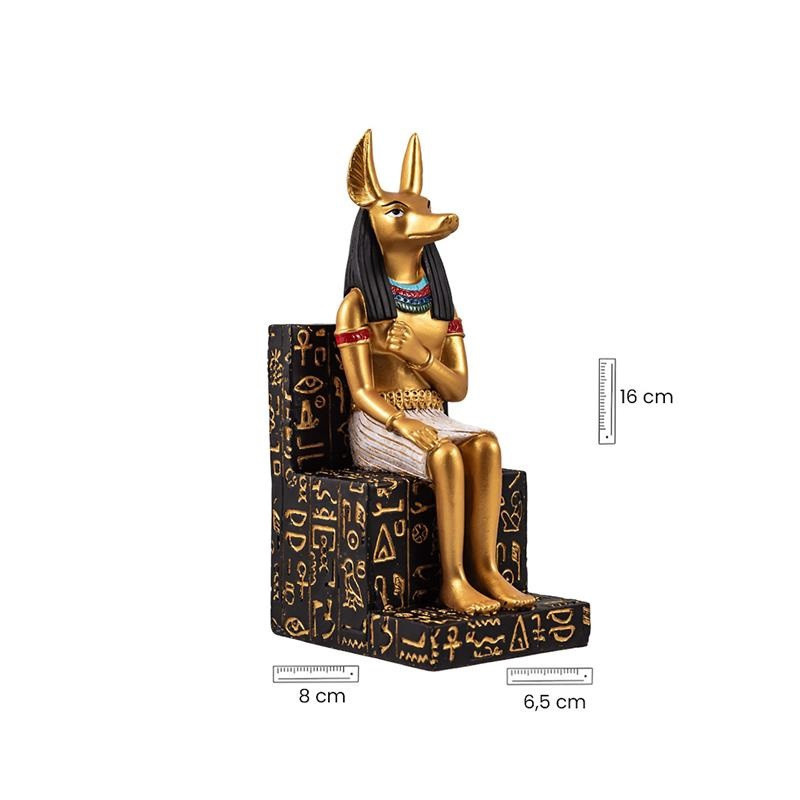







Image of Anubis
Size: Approximately 16 cm tall.

Security policy

Delivery policy
Anúbis was a deus present in the religiosity of Ancient Egypt and was considered one of the two dead and of mummification. He was used as protector of two burial mounds and two non-German dead, but he ended up losing some of these attributes to Osiris. The Egyptians are portrayed with the head of a jackal, and reproductions of the images of these gods were found in Egyptian tombs.
Anubis was an Egyptian deus represented with the face of a jackal.
It was considered the death of the dead and the mummification.
As time, these attributes of Anubis are related to Osiris.
Anúbis was also considered the guide of non-German dead or the protector of burial mounds.
Anúbis was the first of the two dead in Egyptian religiosity, but, as time went on, the attributes of Anúbis became related to Osíris (another important Egyptian deity), as well as his connection with the dead and his mummification. There is some confusion about two gods and also the modifications of the myths that Anubis enveloped.
Anúbis is not a significant figure in Egyptian myths. The ascension of Osiris was due to Anubis becoming the son of Osiris and Nephthys, but there are variations in mythology that affirm that he was the son of Hesat and Bastet, for example. As the importance of Osíris increased, Anúbis was converted into a kind of auxiliary of the gods who protected the burial mounds and guided the non-German dead.
The Egyptians credited that Anubis was two gods who were present at the Court of Osiris, a place where the dead were judged and in which it was defined whether they would enjoy life after death or be devoured by a monster. Osíris played a role in the balance that weighs the heart of death (representing his actions) and a penalty (representing the concept of justice).
Because he guarded two burial mounds, it was proven that Anúbis was responsible for all those who violated these localities. The Egyptians referred to Anubis as Anpu or Inpu. Anúbis, in turn, is a term native to the Greek language.
Regarding the birth of Anubis, there is an Egyptian myth that narrates this event. The birth of this story was the result of a relationship between Osíris and Nephthys, from the beginning of the night. He has affection for Osíris, for now he is very beautiful. Thus, she disguised herself as Isis (Osíris's wife) and deitou-se com esse deus.
Nephthys was pregnant with Osiris, giving birth to Anubis, but after she was abandoned, she feared that her husband, Set, would discover her betrayal. Isis discovered that Nephthys had become pregnant with Osíris and was left behind by her upbringing, resgatando-a and raising-a as she found her own child. He also discovered the event and, enraged, resolved to revenge himself, assassinating Osiris.
One of the two locations that centralized the cult of Anubis in Ancient Egypt was the city of Saka, which was established in Upper Egypt. Além disso, there were sanctuaries for Anúbis spread throughout the Egyptian territory. The relationship between God and death fez as he transformed into the patron saint of Memphis, a city that had necropoles behind Egypt. In Mênfis, Anúbis was the patron of embalming. The cult of Anubis was very popular in Egypt and reached other people, such as the cuxitas.
These were not the only existing forms of worship of these Egyptian hairs:
There were priests who used jackal-shaped masks during rituals in local worship;
amulets were used in reference to this deus;
There were images of Anúbis in the tombs in his homage.
Ainda, the devotion of two Egyptians to Anúbis was marked by the fact that a series of epithets was given to this deus in reference to his attributes. He was called the Egyptian hairs of “the first Westerner.” “Western” was a word used to refer to those who lived non-German. He was also known, among many other students, as “mestre dos segredos”, because he knew that he expected non-German deaths.
As we can see, both the epithets and the references to this deus in Egyptian culture reinforce its association with death and its relationship with funerary practices and beliefs of Egyptians in life after death.